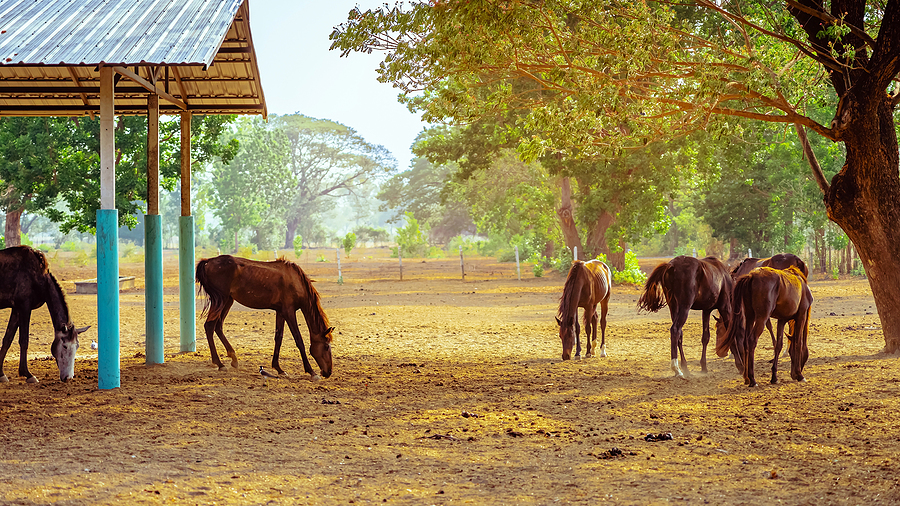Go to a boarding stable with a variety of housing options for horses and you’ll see that box stalls are the most expensive choice. Many horse owners think a 12×12 walled enclosure is the best way to keep their equine companions, putting box stalls in high demand. They believe box stalls are the best home for a horse because equine occupants are provided with cushy shavings and protection from the elements.
In reality, box stalls aren’t the best way to house a horse. A look at the natural history of horses makes it easy to see why. Horses evolved to be outdoors, in groups, moving for as much as 18 hours a day. A horse living in a box stall is isolated from other horses, and is unable to walk around freely. Add to that a lack of sunshine and poor ventilation—a problem with many box stalls—and you have a living situation that is unnatural for a horse.
“Horses in box stalls are much more likely to develop behavioral or problems—stable vices—most of which can also have medical consequences,” says Stacie Boswell, DVM, an equine veterinarian with Hardaway Veterinary Hospital in Belgrade, Montana. She explains that these behaviors can be divided into oral and movement-associated behaviors. Oral behaviors are lip-flapping, wood-chewing, running teeth along bars to make noise, and cribbing. Movement-associated behaviors include pawing, pacing and weaving.
“The oral stereotypies can lead to tooth damage or even lacerations to a horse’s tongue or lips,” says Dr. Boswell. “Cribbing, specifically, wears down incisors and increases risk of colic.”
Movement-associated behaviors can lead to orthopedic injuries or lameness problems.
Natural Living
So what is the solution to housing horses? The answer is to best mimic a life most natural to the horse.
“In the ideal world, horses should have access to an area where they can interact and socialize with their preferred herd members, move freely, have access to water, salt, and/or minerals, and forage,” Boswell says. “The enclosure should be safe and humane, and shelter from wind, precipitation, or hot sun should be provided.”
Meeting these needs can be challenging for most horse owners.
“Only the most wealthy land owners with a large area can provide an ideal amount of pasture space,” Boswell says. “In addition, even in a small herd of two or three individuals, it’s possible for the horses to not get along with each other. Safe and humane fencing is difficult. I’ve seen horses hurt on nearly every kind of fence.”
Meeting Equine Housing Needs
Regardless, it’s up to horse owners to try to find the most natural living situation for their horses. The following Fear Free tips can help.
“Within the confines of a person’s resources, the best thing to do is to know and watch your horse and make sure that you do everything in your current power with your current resources to help a horse feel comfortable and safe, and allow him social time as much as possible,” says Boswell. “It’s all about mental stimulation and socialization, along with exercise.”
Play and Mental Stimulation
If a horse doesn’t have access to free movement, then any turnout time is helpful, even if it’s just free time in an arena, Boswell says.
“Can another horse friend be turned out with them? The absolute bare minimum would be allowing a horse to ‘play’ while on the lunge line,” she says. “This at least would give him some freedom of movement.”
Another way to help a horse’s mental stimulation includes hand-grazing or hand-walking.
“Getting out to see something other than the same four walls is better for anyone’s mental health, whether that’s horse or human,” says Boswell. “Fresh air, and access to sights and sounds alleviates boredom.”
For horses who don’t live on pasture, slow-feeders that increase the time a horse spends eating forage decrease the amount of time the horse is just standing around feeling bored and lonely. Stall toys, such as balls or food-dispensing objects, are also useful for mental stimulation, especially if they’re used for a few days and then rotated out for variety.
Horse owners can also help provide some of the stimulation and companionship a horse might receive from an equine companion.
“If a horse isn’t allowed to mutually groom with another horse, the human can pay extra attention to the withers, neck, and back when grooming—areas where horses most often groom each other—or other body areas as the horse indicates what he or she enjoys most,” says Boswell.
Understanding that horses need freedom of movement, companionship, and mental and physical stimulation—and taking these factors into account when planning your horse’s living situation—will go a long way in helping you to reduce fear, anxiety, and stress and provide a happy, healthy life for your equine companion.
This article was reviewed/edited by board-certified veterinary behaviorist Dr. Kenneth Martin and/or veterinary technician specialist in behavior Debbie Martin, LVT.
Audrey Pavia is a freelance writer and author of Horses For Dummies and Horseback Riding for Dummies. She lives in Norco, California, with her two Spanish Mustangs, Milagro and Rio.
Want to stay in the loop on the latest and greatest in keeping your pet happy and healthy? Sign up for our free newsletter by clicking here!








